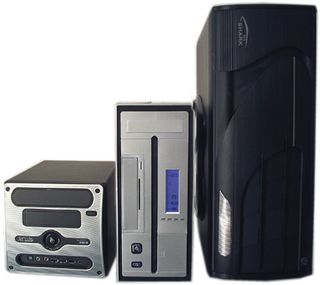Casing Out MicroATX
MicroATX Cases For Build-it-yourself PCs

MicroATX (center) is nearly 50% smaller than a midi tower (right) with almost twice the space of a small form-factor PC (SFF-PC, on the left).
There are different ways to get your dream computer. The easiest route is to go to your local reseller and pay someone to assemble your PC just the way you want it. However, that approach can quickly put a strain on your wallet. Or you can buy all the individual components and tediously tinker away until you get the thing put together yourself.
A third option is to get a small form-factor PC, which as most readers know comprises a very small case pre-packed with a motherboard, power supply and other goodies, but usually doesn't come with a CPU or memory module. However, a small form-factor PC is not always the way to go either, as only a few components can be added on inside. Enthusiasts are also aware of potential heat problems caused by computing-intensive applications with a small form-factor PC system.
Opting to start out with a MicroATX case represents an alternative solution, although you will still have to tinker around with the system by installing the motherboard, CPU and memory yourself. The MicroATX form factor is not much larger than a small form-factor PC system, although it can accommodate many more components inside. Most MicroATX cases have space for several 5.25" and 3.25" drives. There is also a larger selection of motherboards from which to choose, which typically have three PCI slots and one AGP slot. Its smaller dimensions make MicroATX suitable as a compact multimedia PC that still offers flexibility.
A direct comparison between small form-factor PC and MicroATX motherboards reveals that the former has a maximum of two slots. These are usually limited to AGP and PCI. Recently a PCI Express port has also been added on. MicroATX boards on the other hand offer a larger number of ports, affording greater customization potential. The number of expansion options varies by maker and model. There are even boards on the market for the new Pentium 4 Socket 775 and Intel's latest chipset, the 925X (see overview ).
For the Athlon64 or the Sempron processor (ex-Athlon XP), the selection is more meager. Only a few models support AMD's new draft horse. Some board makers such as MSI also offer motherboards with an ISA slot. The current trend indicates however that this interface is already destined for the scrap heap. That applies for AMR and CNR too, which are no longer of use. PCI Express is the future.
Regarding the price you will have to pay for a complete MicroATX PC, you will first need to buy and build many of the components yourself to have a starting system comparable to what you get when you buy a small form-factor PC. First, there is the case, with the power supply, which will account for about $75 of the total. Added to that is the motherboard, which can easily cost more than $100, and for the CPU fan, you have to throw in another $20. That adds up to not only buying a bunch of individual components but also represents a lot of work you must do to install the hardware. For that kind of money you can also get an almost fully-assembled small form-factor PC. And the installation required is strictly minimal with a small form-factor PC, limited to putting in the CPU, the memory and the drives. Setting up a build-it-yourself MicroATX is thus a good deal more involved compared to a small form-factor PC.
Stay on the Cutting Edge
Join the experts who read Tom's Hardware for the inside track on enthusiast PC tech news — and have for over 25 years. We'll send breaking news and in-depth reviews of CPUs, GPUs, AI, maker hardware and more straight to your inbox.
Current page: MicroATX Cases For Build-it-yourself PCs
Next Page A Smaller-sized Small Form-factor PC Mobo-
Nicoia Can anybody, please help me .....!! I'm looking for the AOpen XC Cube EX945 GC - from the 3 Cases, that are in the front of this web page... The silver & black X Cube... Can anybody help me, in telling me where I, can buy or get one .... Thanks & best regards ...Reply
Most Popular


